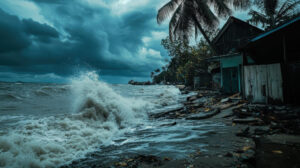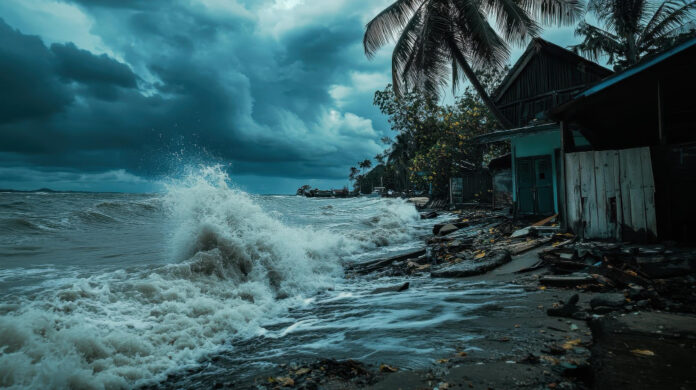Tropical Storm warning Helene is on a collision course with the Gulf Coast, and it’s intensifying by the hour. Whether you’re a weather enthusiast tracking every storm or a Gulf Coast resident gearing up for the worst, we’ve got all the details you need to stay ahead of this potential disaster.
Tropical Storm Warning Helene?
Tropical Storm Helene is the latest system churning through the Atlantic, and it’s already making headlines. Formed only days ago, Helene has rapidly gained strength, showcasing the typical behaviour of storms in this part of the world. Meteorologists are closely monitoring its progress, and the current models predict a significant impact on the Gulf Coast.

The Forecasted Path of Helene
Helene’s trajectory has been a hot topic among meteorologists. Current forecasts show the storm cutting across the Caribbean before making its way toward the Gulf Coast. The models suggest landfall could occur anywhere from Texas to Florida, with varying degrees of intensity. With weather patterns constantly changing, it’s crucial to stay updated on Helene’s path.
Areas Most at Risk
The Gulf Coast is vast, and some areas are more vulnerable than others. Residents in low-lying regions, particularly those along the Louisiana and Texas coastlines, should be on high alert. These areas are historically prone to flooding and storm surges, making them prime targets for Helene’s wrath.
Why Early Preparations Matter
When it comes to tropical storms, early preparation can be the difference between safety and catastrophe. Helene is still gathering strength, so now is the time to get your emergency plans in place. Don’t wait until the last minute when stores are out of supplies and roads are clogged with traffic.
Building Your Emergency Kit
An emergency kit is your first line of defence during a severe weather event. Here’s what you should include:
- Water: At least one gallon per person per day for three days.
- Non-Perishable Food: Enough to last each person several days.
- First Aid Supplies: Bandages, antiseptics, and any prescription medications.
- Flashlights and Batteries: Power outages are common during storms.
- Important Documents: Keep copies of identification, insurance policies, and medical records.
Evacuation Planning Tips
Evacuation might become necessary if Helene continues to strengthen. Plan your evacuation route now and make sure all family members know it. Identify several places where you can stay, such as with friends, family, or at a hotel outside the impacted area. Don’t forget to account for pets in your evacuation plans.
Insights from the Experts
We’ve gathered some insights from local meteorologists and emergency response officials to give you the edge in preparing for Helene.
Meteorologist’s Perspective
Local meteorologists from the National Weather Service have emphasized the unpredictability of storm paths. While models provide a general idea, conditions can change rapidly. They recommend keeping a close eye on updates and warnings and encourage residents to take all advisories seriously.
Emergency Response Tips
Emergency response teams highlight the importance of community readiness. They stress that individual actions can significantly mitigate the overall impact. By preparing now, you’re not only protecting yourself but also making it easier for emergency services to do their job effectively.
Real-Life Stories from Previous Storms
Nothing drives home the importance of preparedness like real-life stories. Take, for instance, the case of Hurricane Katrina survivors who had well-prepared plans and supplies. Their foresight allowed them to weather the storm and assist others in need. On the flip side, many who were unprepared faced dire consequences.
Lessons Learned
Survivors from previous storms often share a common message: don’t underestimate the power of nature. Even if you’ve lived through several storms, each one is different, and complacency can be deadly. Take every warning seriously and act swiftly.

Community Resources
Several community resources are available to assist those in need during and after the storm. Local shelters, food banks, and volunteer groups are ready to provide support. It’s essential to know where these resources are located and how to access them if necessary.
Post-Storm Safety and Recovery
The storm may pass, but the danger isn’t over once the skies clear. Knowing what steps to take after the storm is crucial for your safety and recovery.
Immediate Actions
Once the storm has passed, assess your surroundings carefully. Avoid downed power lines and flooded areas, as these can pose significant risks. Check on neighbors, especially the elderly and those with young children, to ensure everyone is safe.
Long-Term Recovery
The aftermath of a storm can be devastating. It’s important to document all damage for insurance claims and seek assistance from local authorities and organizations. Rebuilding takes time, and having a plan in place can streamline the process.
Anticipating Long-Term Impacts
The long-term impacts of Tropical Storm Helene on the Gulf Coast could be significant. From economic repercussions to environmental changes, understanding what to expect can help communities prepare better for the future.
Economic Effects
Storms like Helene can disrupt local economies, particularly in tourism and fishing industries. Businesses may face closures, and recovery can be a slow process. However, with proper planning and support, communities can bounce back stronger.
Environmental Changes
Severe storms often alter landscapes, erode coastlines, and affect wildlife habitats. The Gulf Coast is a delicate ecosystem, and the impact of Helene could have lasting effects. Conservation efforts and environmental protections will be crucial in the recovery phase.
Get Prepared Now
Tropical Storm Helene is a stark reminder of the power of nature and the importance of readiness. By staying informed, preparing early, and knowing what to do before, during, and after the storm, you can protect yourself, your loved ones, and your community.
Remember, every action counts. Start building your emergency kit today, plan your evacuation route, and stay updated with the latest information. For more detailed guidance and resources, consider signing up for our emergency preparedness newsletter. Stay safe, and be prepared.
Helpful External Resources
For detailed Tropical Storm warning information and helpful tips on preparing for tropical storms and hurricanes, check out the following resources:
- Ready.gov on Hurricanes – Tropical Storm warning This government site offers comprehensive guidance on how to prepare for hurricanes, including making an emergency plan and building a kit.
- The National Hurricane Center – Tropical Storm warning Stay updated with the latest storm forecasts, advisories, and warnings from the experts.
- Red Cross Hurricane Safety – Learn about the Red Cross’s recommendations for hurricane preparedness and response.
- Environmental Protection Agency (EPA) Stormwater Management – Find strategies for managing flood risks and protecting water quality during severe weather events.
Remember, staying informed is key to protecting yourself and your community. Don’t wait for the storm to arrive—start preparing now!
Stay Informed with Latest Updates
For more insights into current affairs and their impact on our daily lives, visit FitbizHouse Current Affairs. This platform offers engaging and lively updates on various topics, helping you stay in the loop. By staying informed, you’re better prepared to make decisions that affect both your personal life and the community around you. So, dive in and catch up with the latest happenings!

This post keeps you informed and ready for the storm. Join our community and stay one step ahead with expert advice and tips.


